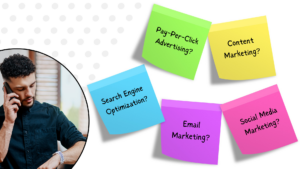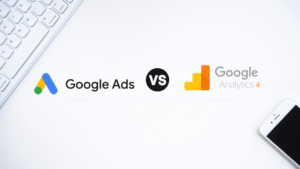While these terms sound similar and are often used interchangeably, the subtle differences between the two can significantly impact the effectiveness of your digital marketing efforts. Understanding each strategy and when to employ it (or when to use them together) is pivotal for any marketing professional aiming to maximize their ROI and effectively engage their target audience.
This is what you’ll find in this blog to learn all about these strategies:
What is Retargeting?
 Retargeting is a digital marketing strategy that involves engaging users who have shown prior interest and encouraging them to move down the marketing pipeline. This is usually accomplished with personalized, targeted ads.
Retargeting is a digital marketing strategy that involves engaging users who have shown prior interest and encouraging them to move down the marketing pipeline. This is usually accomplished with personalized, targeted ads.
The retargeting process might look something like this:
- A user visits a website.
- The user browses some products, but leaves without making a purchase.
- Leveraging this potential customer’s data, they’re shown a relevant, targeted ad on social media or search pages.
- The targeted user clicks the ad and returns to the website, finishes their checkout, and becomes a customer.
Retargeting is a great way to gently remind leads of their prior interest and encourage them to return to your website. Segments of your audience can be retargeted based on numerous onsite interactions, including browsing, entering your site from a social media platform, or even subscribing to an email list but never making a purchase.
What is Remarketing?
 Remarketing, on the other hand, is a strategy primarily used to re-engage past or current customers with messaging based on their previous interactions with a brand. This approach focuses on maximizing customer lifetime value (CLV) by reconnecting with those who have already made a purchase or shown interest.
Remarketing, on the other hand, is a strategy primarily used to re-engage past or current customers with messaging based on their previous interactions with a brand. This approach focuses on maximizing customer lifetime value (CLV) by reconnecting with those who have already made a purchase or shown interest.
Remarketing most commonly takes the form of personalized messages that are sent to consumers who have previously made a purchase from a website. This strategy can have a big impact on your ROI, because it directly engages with the users who are most likely to convert.
Not only is this tactic great for keeping your brand top-of-mind with past customers, but utilizing free or low-cost messaging channels is also one of the most cost-effective ways to reach your target audience.
Tactics and Tools
 One of the main differences between retargeting and remarketing are the digital marketing tools used to accomplish them.
One of the main differences between retargeting and remarketing are the digital marketing tools used to accomplish them.
A retargeting marketing strategy primarily uses targeted display ads based on a user’s site or social media activity. At the heart of this method is the utilization of cookies or tracking pixels, which can be used to follow a user’s online behavior. This personalized approach enables brands to deliver highly relevant and timely ads, significantly increasing the likelihood of conversion.
Remarketing uses messaging (primarily email and/or texts) to communicate with customers, utilizing data on their past purchase activity or site actions to keep them engaged. Examples of these marketing messages could include “reminders” to act on their previous search history or upselling an add-on product or service that compliments a recent purchase.
In the end, both strategies utilize valuable tools for nurturing leads and supporting a holistic customer lifecycle marketing plan. In their own way, they each enable targeted engagement with audiences who are already familiar with your business, helping to encourage purchases and build long-term brand recognition with a loyal customer base.

Retargeting and Remarketing: Potential Challenges
While retargeting ads and remarketing messages offer numerous benefits and can significantly enhance marketing campaigns, they also come with their fair share of challenges. These can include:
- Ad Fatigue: One of the main issues encountered with retargeting ads is the risk of ad fatigue. When users are shown the same ads over and over, they can become desensitized or even annoyed – leading to decreased engagement and effectiveness. To prevent this from happening, marketers must be sure to control the frequency of their ads and employ rotation strategies to ensure a diverse mix of content.
- Audience Segmentation: Effectively segmenting your target audience is crucial for delivering relevant, personalized messaging. However, targeting customers based solely on their past interactions may not paint a full picture of their preferences and behaviors. As a solution, it’s important to leverage a variety of data analytics to identify distinct audience segments and craft campaigns accordingly.
- Privacy Concerns: With growing concerns over data privacy, retargeting and remarketing need to be done carefully to avoid infringing on privacy rights. Striking the right balance between personalization and privacy is crucial, as overly intrusive or aggressive methods can alienate users and even tarnish your brand’s reputation. Adhering to industry regulations and obtaining data collection consent from users is essential for building trust and maintaining compliance.
How to Choose Between Retargeting vs Remarketing
 As part of a holistic marketing plan, both retargeting and remarketing can be excellent ROI-boosting additions to your campaign strategy. Ultimately, the choice between retargeting vs remarketing depends on your specific marketing objectives and the nature of your audience.
As part of a holistic marketing plan, both retargeting and remarketing can be excellent ROI-boosting additions to your campaign strategy. Ultimately, the choice between retargeting vs remarketing depends on your specific marketing objectives and the nature of your audience.
Retargeting aims to target potential customers across the web, encouraging them to return to your site while improving brand recognition. If your most important goal is to convert website visitors who have shown interest but haven’t yet made it to the checkout screen, retargeting with online ads might be the more effective choice.
On the other hand, if your company aims to increase loyalty and repeat business from existing customers, remarketing through personalized email or text campaigns would be more beneficial. Using detailed customer data through this approach will allow you to send relevant messages, offers, and reminders, deepening the relationship with your customer base.
If you still find yourself struggling to pick one strategy over the other, here’s some great news – you don’t have to! Retargeting and remarketing efforts can absolutely be used in combination with each other. In fact, this may yield even greater results. Many businesses have found success by integrating both strategies, using retargeting to attract and convert new customers and remarketing to nurture and retain existing ones.
No matter which option you choose, having an effective, well-rounded marketing plan in place can make all the difference. Ready to elevate your brand’s online strategy? The expert marketing team at Professional PUNCH is here to guide you every step of the way. Contact us today and let us help you transform your digital marketing strategy to achieve the remarkable results you’ve been searching for.






